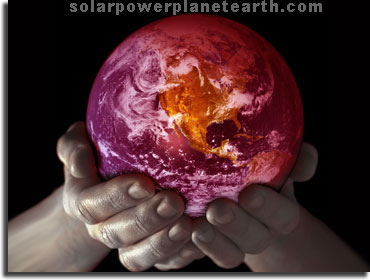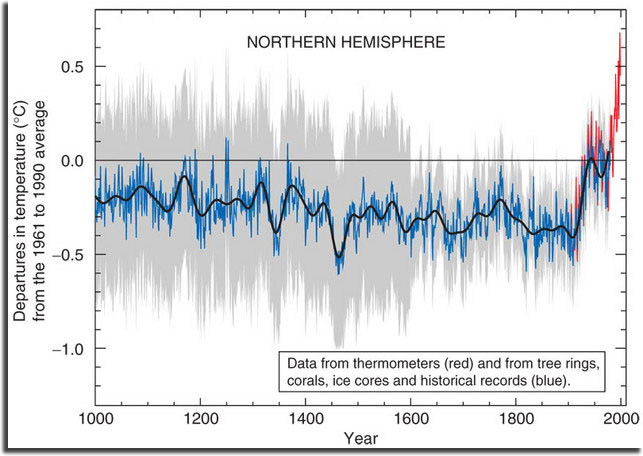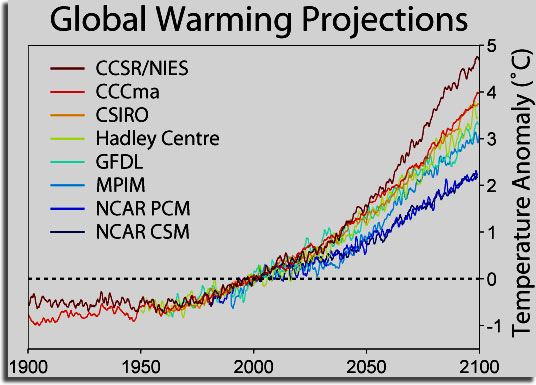 |
Global Warming
According to NASA's Goddard Institute for Space Studies, average temperatures have climbed 1.4°F (0.8°C) since the end of the 19th century, much of which has happened in the recent past. In the United Nations Intergovernmental Panel on Climate Change (IPCC) Third Assessment Report (TAR), a controversial graph, known as the "hockey stick graph," due to it's hockey stick like shape. This graph, shown below, shows data which was compiled from tree rings, thermometers (recent past), ice cores, and historical records.

The paper which was published in 1999 by Michael E. Mann, has received a lot of attention from people on both sides of the debate. The statistical methods used to produce the graph have been challenged repeatedly by skeptics, however, many subsequent scientific papers which used different statistical techniques generally came to the same conclusion.
It is important to note that the effects of global warming are not distributed evenly over the planet, as some areas are impacted more adversely than others.
The Greenhouse Effect 
Certain gases, particularly carbon dioxide, methane, water vapor, and ozone, have a unique property of absorbing and emitting infrared radiation (heat). This trapping of heat, acts as a blanket around the earth, keeping it warm at night, and allowing a higher average temperature, which in effect permits life on our planet.
An extreme case of this can be seen on our neighboring planet of Venus (shown to the right), where it's 96.5% carbon dioxide atmosphere help to create and maintain a surface temperature of 860 degrees Fahrenheit. Even though Venus is twice as far from the Sun as Mercury, it has a hotter surface temperature because of this extreme greenhouse effect.
Some Facts
Effects of Global Warming
The probability of hurricanes in increasing intensity and power will increase with rising ocean temperatures as we have observed during "El Nino" years.
In addition to heat related illnesses, elevated air temperatures will cause widespread droughts that not only limit access to fresh water, but have a huge impact on agriculture and food supplies, which could lead to local and global conflicts fighting over the limited sources of food and fresh water. This alone could end life on our planet depending on how far these conflicts escalate.
The gradual disappearance of arctic ice will have grave effects on the local ecosystem and potentially cause the extinction of some species of animals. Melting of permanent snow and ice on land will cause the oceans to rise. If all of the worlds permanent snow and ice were to melt today, the ocean levels would rise over 200 feet! Even a slight rise in sea level would be devastating to places like Florida, along with many other beach front communities. Lighter colored surfaces reflect more light. Snow and sea ice is white, which naturally reflect a lot of incident sunlight. If these melt, greater amounts of sunlight will be absorbed by the darker colored ocean and land mass underneath. If this delicate balance reaches a certain threshold, it could lead to the point of no return and a run-away warming of our planet.
The following graphic shows various climate model predictions to the year 2100 of global warming, assuming no precautions are taken to help reduce human greenhouse gas emissions. Each model used the same data set, taken from the Intergovernmental Panel On Climate Change (IPPC).

Note that most experts agree that an average temperature rise of more than 3°C will have a widespread negative impact on our planet and way of life.
Conclusions
Since the issue of global warming is a very complex scientific problem dealing with mathematically chaotic weather patterns, ocean currents and temperatures, and human greenhouse gas production, it will be very difficult for anyone to accurately predict the future of our planet. Global warming has been debated for some time now, and will continue to be debated into the foreseeable future. The evidence is significant enough however, that international communities are forming comities and coming together to curb their countries greenhouse gas emissions. Anyway you look at it, whether you believe global warming is fact or fiction, turning to clean, renewable sources of energy like solar power, wind power, geothermal, and tidal, will only benefit us as a species. The benefits of using solar power are far reaching and should be considered either way.